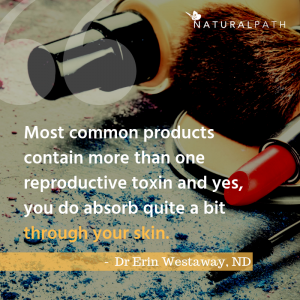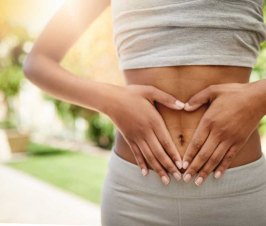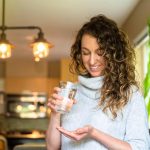One of the most overlooked factors in the conventional fertility world is the impact environmental toxicity has on a couple’s ability to reproduce. Frequently, the couples who come into my office looking for support with fertility have no known reason to explain their difficulty getting pregnant. Sometimes they’ve already had a standard work-up by the local fertility specialist and have been given the wildly unsatisfying diagnosis of “unexplained infertility.” As though struggling to conceive or keep a pregnancy to term wasn’t difficult enough, not knowing why can be especially frustrating. Perhaps there is a diagnosis: oligospermia (low sperm count) or endometriosis (when the tissue that lines the uterus grows outside the uterus). Most couples are still left wondering what can I do? Whether the couple is committed to getting pregnant without assisted reproductive technology or wants to increase the chances of success with IVF, addressing the impact of environmental toxicity on their fertility can be a very important step.
Some starting places for how to reduce exposure and improve the odds of bringing a beautiful baby into the world
 The fact is we live in a world that has more reproductive toxins than ever before. What little safety testing that is done on the compounds we’re exposed to on a daily basis rarely, if ever, takes into account the cumulative effect of being exposed to so many different substances at once. What we do know is that some of the compounds you likely use all the time can cause significant harm to the reproductive system. While this is by no means an exhaustive list, here are a few starting places for how to reduce exposure and improve the odds of bringing your beautiful baby into the world.
The fact is we live in a world that has more reproductive toxins than ever before. What little safety testing that is done on the compounds we’re exposed to on a daily basis rarely, if ever, takes into account the cumulative effect of being exposed to so many different substances at once. What we do know is that some of the compounds you likely use all the time can cause significant harm to the reproductive system. While this is by no means an exhaustive list, here are a few starting places for how to reduce exposure and improve the odds of bringing your beautiful baby into the world.
Health and Beauty Products
This means anything you use on your body for grooming from your toothpaste to your hand soap to your perfume or cologne. Most mainstream products contain more than one reproductive toxin and yes, you do absorb quite a bit through your skin. These products can frequently contain formaldehyde, phthalates, harmful metals, and other endocrine disrupting compounds and they aren’t always labeled in a way to make it obvious. Phthalates are some of the most common reproductive toxins and are used frequently in these products as solvents and to help scents last longer. Among other negative effects, phthalates can decrease and disrupt normal hormonal function in men and women. If you have a product that contains “fragrance” or parfum, it’s almost certainly a phthalate. Parabens are also common in these products and can reduce the number of developing follicles in the ovary and shorten menstrual cycles so eggs are used up faster. What to do? Look for healthy replacements for any product you use directly on your skin. Generally I recommend avoiding synthetic ingredients in general. If that feels too difficult, try using a resource like Skin Deep from Environmental Working Group or the Think Dirty App for some safer suggestions.
Food Containers
 Plastic food containers have myriad toxic elements as well, that, you guessed it, do leach into your food. Phthalates – in addition to being used in your favorite soaps and shampoos – are also used in plastics. BPA is another common plasticizing agent that is known to have profound estrogenic properties and to disrupt normal cell replication, both of which can be quite problematic for those trying to get pregnant. In fact, higher levels of BPA are associated with higher rates of miscarriage . What about BPA free plastic? I’m afraid that’s not safe either. Many of the replacements for BPA such as BPS and BPF are as bad if not worse than BPA. Note that the largest source of BPA in the environment is actually paper receipts and again, yes, you absorb it through your skin just from touching the receipt. What to do? Replace your food storage containers with glass or stainless steel. Try to avoid take-out packaging – even the paper packaging contains reproductive toxins. If you must take your receipt, wash your hands right after handling it.
Plastic food containers have myriad toxic elements as well, that, you guessed it, do leach into your food. Phthalates – in addition to being used in your favorite soaps and shampoos – are also used in plastics. BPA is another common plasticizing agent that is known to have profound estrogenic properties and to disrupt normal cell replication, both of which can be quite problematic for those trying to get pregnant. In fact, higher levels of BPA are associated with higher rates of miscarriage . What about BPA free plastic? I’m afraid that’s not safe either. Many of the replacements for BPA such as BPS and BPF are as bad if not worse than BPA. Note that the largest source of BPA in the environment is actually paper receipts and again, yes, you absorb it through your skin just from touching the receipt. What to do? Replace your food storage containers with glass or stainless steel. Try to avoid take-out packaging – even the paper packaging contains reproductive toxins. If you must take your receipt, wash your hands right after handling it.
Food
Let’s assume for a minute that you’ve done a great job of avoiding packaged foods and you’re eating a whole foods diet. That’s a good start as far as avoiding the hormone disrupting chemicals in the packaging itself. Now it’s time to pay attention to the food. In the United States, most commercially grown food will contain some pesticides. Organic isn’t perfect, but it can reduce exposure. Studies have shown a decrease in female fertility due to pesticide exposure and males eating fruits and vegetables with less pesticide residue had higher sperm concentrations. Some pesticides (even some that have been banned for years) persist in the environment and build up in animals, so choosing organic food and limiting consumption of dairy and meat can help reduce exposure. Increasing fiber in your diet by eating more whole grains, beans, legumes, vegetables, and fruit will also help decrease the amount of toxic chemicals your absorb from your food. Eating a variety of brightly colored fruits and vegetables in larger quantities (5 cups/day) can also increase the nutrients your body needs to help deal with exposure to some of the reproductive toxins you can’t avoid.
Furniture and Clothing
Furniture and clothing are often treated with endocrine disrupting or other harmful chemicals in the manufacturing process. Some of these are barriers, such as in a stain resistant couch or carpet. Others are flame retardants in couches, pillows, and mattresses. One study showed a significant drop in egg fertilization for couples undergoing IVF when the male had higher levels of brominated flame retardants. Looking for furniture and rugs that do not contain chemical flame retardants or stain or odor guards is a good place to start. Mattresses contain myriad of toxic substances, but can often be made without flame retardants with a note from you doctor. This won’t remove all the chemicals, but it’s a start.
The list above is just to get you moving and even if every recommendation were followed, it wouldn’t completely eliminate exposure. That’s why it’s so important to make sure nutrition is in place to provide the nutrients to help your body cope with what you can’t avoid. Sometimes beginning to look into the toxins that are silently harming fertility (and health!) can be overwhelming. If you want advice on how to prioritize or testing to see which chemicals are highest in your own body, a naturopath with specific training in environmental medicine and fertility is a good place to start. They can help you make a plan that will boost your fertility while you detoxify. Keep in mind that an egg and sperm take 3-4 months to mature and that is when they are most vulnerable to these exposures, so reducing exposure 6 months before trying to get pregnant is always ideal, but it’s never too late (or too soon) to start making safer choices for your body and your growing family.
Sources:
[1] Bloom, MS et al. Associations between urinary phthalate concentrations and semen quality parameters in a general population. Hum Reprod. 2015 Nov; 30(11): 2645–2657. PMID: 26350610
[2] Rattan, S. et al. Exposure to endocrine disruptors during adulthood: Consequences for female fertility. J Endocrinol. Author manuscript; available in PMC 2018 Jun 1. Published in final edited form as: J Endocrinol. 2017 Jun; 233(3): R109–R129. PMID: 28356401
[3] Yueping, S. et al. Higher Urinary Bisphenol A Concentration Is Associated with Unexplained Recurrent Miscarriage Risk: Evidence from a Case-Control Study in Eastern China. PLoS One. 2015; 10(5): e0127886. Published online 2015 May 26. doi: 10.1371/journal.pone.0127886. PMID: 26011304
[4] Rattan, S. et al. Exposure to endocrine disruptors during adulthood: Consequences for female fertility. J Endocrinol. Author manuscript; available in PMC 2018 Jun 1. Published in final edited form as: J Endocrinol. 2017 Jun; 233(3): R109–R129. PMID: 28356401
[5]Chiu YH, et al. Intake of Fruits and Vegetables with Low-to-Moderate Pesticide Residues Is Positively Associated with Semen-Quality Parameters among Young Healthy Men. J Nutr. 2016 May;146(5):1084-92. doi: 10.3945/jn.115.226563. Epub 2016 Apr 13.
 Dr Erin Westaway, ND is a naturopathic physician with a private practice in Seattle, WA, where she focuses on fertility, preconception care, and teaching parents how to grow healthy families. A portion of her practice is dedicated to primary care medicine. She recently founded Well Conceived – a virtual natural fertility coaching program.
Dr Erin Westaway, ND is a naturopathic physician with a private practice in Seattle, WA, where she focuses on fertility, preconception care, and teaching parents how to grow healthy families. A portion of her practice is dedicated to primary care medicine. She recently founded Well Conceived – a virtual natural fertility coaching program.
Dr. Westaway came to medicine through her love of learning, her fascination with the impeccable balance of nature, and her curiosity about the human condition. She studied English literature at Bowdoin College and taught public school before returning to school to become a physician. After graduating from Bastyr University, she completed a two year residency under Dr. Molly (Linton) Niedermeyer at one of the oldest naturopathic clinics in the country, where she continued to practice for several years.
Her private practice was born out of a desire to create a medical practice that allowed enough time and support for true transformation of health. To accomplish this, Dr. Westaway draws on her extensive knowledge of physiology and biochemistry, her awe of human capacity, her love of story, and her first hand knowledge of dealing with chronic illness. In addition to naturopathic training, she has extra training in biofeedback, homeopathy, craniosacral therapy, visceral manipulation, environmental medicine and fertility. Dr Westaway can be found online at www.prescribelifemedicine.com and www.wellconceivedhealth.com

















